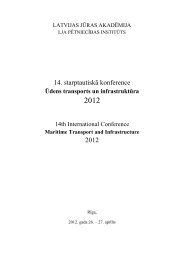You also want an ePaper? Increase the reach of your titles
YUMPU automatically turns print PDFs into web optimized ePapers that Google loves.
ANALYSIS OF SHIPBUILDING INDUSTRY MARKETIN LITHUANIA AND POLANDElena ValionieneLithuanian <strong>Maritime</strong> Academy, 7 I. Kanto Street, Klaipeda, LT-92123, LithuaniaE-mail: e.valioniene@lajm.lt, phone: +370 69836297Algirdas DruktenisLithuanian <strong>Maritime</strong> Academy, 7 I. Kanto Street, Klaipeda, LT-92123, LithuaniaE-mail: a.druktenis@lajm.lt, phone: +370 67590088AbstractLithuanian and Polish shipbuilding industry can be compared according to the external and internalfactors which affect the market. Polish ship building scale exceeds Lithuanian about hundred times. Inthat way authors were looking for main reasons which influenced the increase of shipbuilding inLithuania and decrease in Poland. The process of ship building from drawings to a complete ship isbriefly presented. Data is being analyzed and compared using statistical and graphical analysis. Articlereveals the internal and external factors that affect data variations.Keywords: shipbuilding, shipyard, evaluation, shipbuilding market analysisIntroductionFirst ships, that people built, were timbers powered by hands. Later timbers were tied together andpeople invented rafts, in lands without forests people used reeds instead. First real ships were builtsomewhere about X age B.C. by Phoenicians. These ships were powered by vaulting poles or paddleswhich were fitted in one, two or three rows. Later shipbuilding technologies started developing rapidly.Scandinavian ships were distinguished by great marine properties. In VII century engineers of Venicestarted building Galleys. These narrow and fast ships were used by Europian navies for military purposes.After medieval paddles were replaced by sails, ships were shorter and wider, pole number increased tothree and more [16].In XVIII century vessels appeared with four or even six heights sails like “Kruzenshtern”. Also areaof sail increased to 0.5 hectare and vessels speed increased to 14 knots, so ships were more manoeuvrableand faster. First steel ship was built in England in 1787. It was 21.5 meters length steamer. Sailboats werereplaced by steamers in late XIX century since propellers were perfected. Since middle XX century shipswere fitted with gas turbines or even nuclear reactors.These main historical facts reveal that shipbuilding industry developed side to side with technologydevelopment. Navigation safety and reliability, increasing concern about environment problems anddemand for fast and efficient transport of goods makes shipbuilders apply latest technologies [12]. Butnot everywhere shipbuilding develops in equal rates, because of many factors which affect the process.Consequently it is interesting to analyse what are those factors, that affects industry, shipbuilding processand why there is positive or negative shipbuilding indicators, dynamics and development trends [15].Research purpose – to evaluate development trends of Lithuanian and Polish shipbuilding market.Main tasks: to make shipbuilding market overview; to compare Lithuania’s and Poland’s shipbuilding market indicators; to evaluate dynamics trends of Lithuanian and Polish shipbuilding industry.Research used comparison, statistics analysis, mathematic modelling, results interpretation andgeneralization methods.Review of shipbuilding marketShipbuilding industry produces one of the most important transport tools in the world – ships. Even90% of worldwide trade is based on marine transport, therefore it is being developed according toglobalization conditions. [8].In the 1980s South Korean shipbuilding output grew rapidly, challenging Japan’s dominant positionand finally establishing the Far East as the centre of the world shipbuilding [15]. Community of EuropeanShipyards Associations (CESA) annual report of 2010-2011 years shows that China and all south east74
















